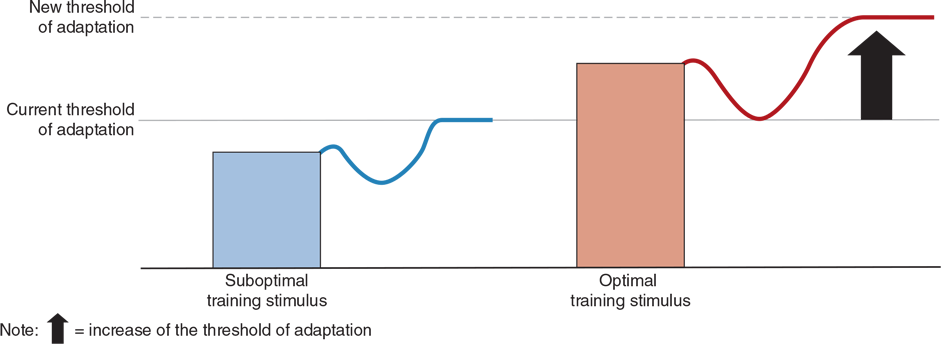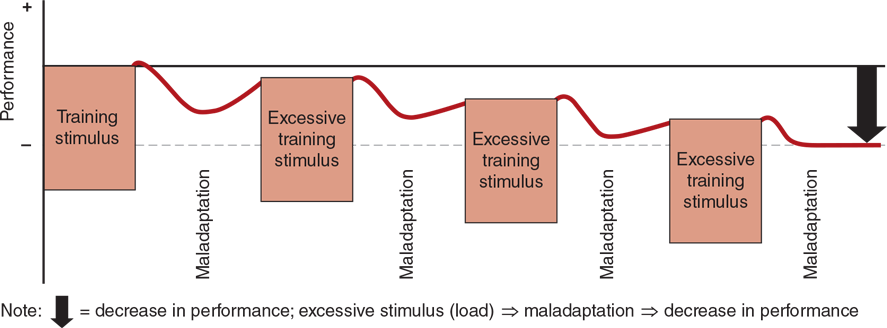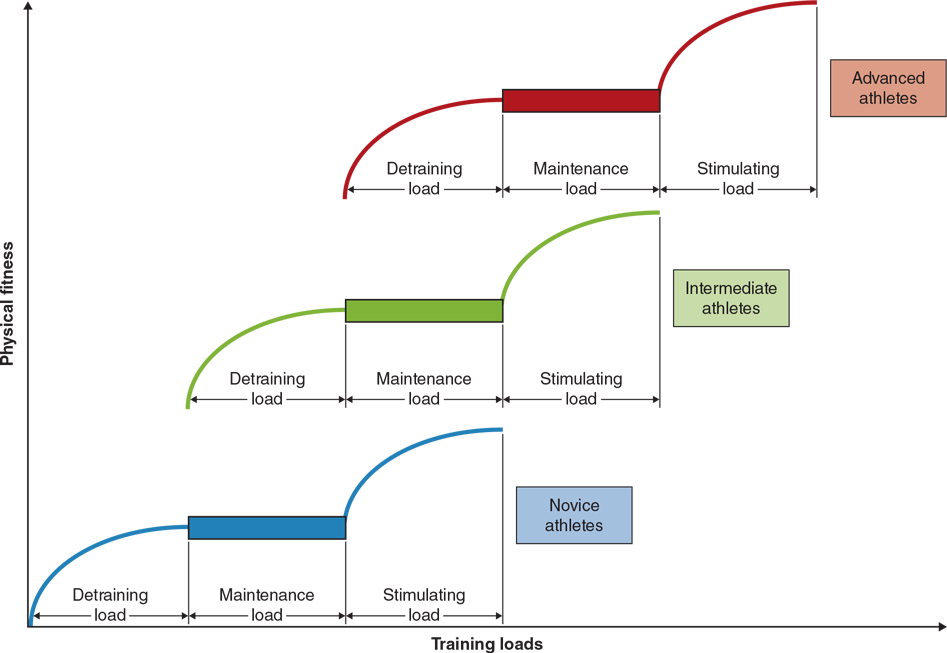What is training adaptation?
This is an excerpt from Scientific Foundations and Practical Applications of Periodization With HKPropel Access by G Gregory Haff.
In its most simplistic sense, adaptation is the process by which an organism adjusts to its environment (222). As the environment changes, the organism must adapt to survive. When extrapolated to the sporting environment, the athlete is exposed to constantly varying workloads from either training or competition that challenge their ability to adapt. If the athlete is unable to adapt to these workloads and the stressors they stimulate, they are at risk of excessive fatigue, overreaching, or overtraining (7). If these stressors are well-planned and varied appropriately, the athlete will be able to adapt and elevate their performance capacity.
Overall, the training loads imposed on the athlete provide powerful stimuli for adaptation (222). The greater the athlete’s ability to adapt to the training stimuli, the greater the potential performance gains. The best method to manage these adaptations and improve sport performance is to use a well-organized periodized training plan that provides varying levels of stressors that align with the ever-changing psychological, physiological, and performance statuses of the athlete. The ability to induce adaptive responses is largely affected by key features of the adaptive process: overload, variation, specificity, reversibility, and individualization (37, 222).
Overload
For the athlete to increase performance capacity, they must be exposed to an exercise overload. An overload is a training load that is above that which the athlete typically encounters (37, 178). If the overload is applied correctly, the athlete will adapt to that training stimulus and achieve a performance gain as a result of breaking the current threshold of adaptation (figure 1.4).

Adapted by permission from T.O. Bompa and G.G. Haff, Periodization: Theory and Methodology of Training, 5th ed., (Champaign, IL: Human Kinetics, 2009).
The most common way to apply an overload is to manipulate the training load by increasing the volume or intensity of training, or some combination of alterations to both of these training variables (37, 79, 101). Training volume can be amplified by increasing the frequency of exposure (i.e., number of training sessions) or the density of exposure (i.e., frequency of training within a period of time) to the training load. The intensity of training can be augmented by increasing the resistance applied (i.e., absolute or relative intensity factors) (37) or the speed at which the activity is performed (38). Alternatively, the training load can be increased by changing the exercise to a novel activity (94, 101, 114, 196, 222) or to a different range of motion (37, 38) that provides the athlete with a stimulus that they are unaccustomed to in order to stimulate adaptation. If applied correctly, the increased training load stimulates adaptations that result in improved performance and a reduced risk of injury (figure 1.5).

Adapted from Bompa and Haff (2009).
If, however, the training load is always the same (i.e., monotonous), it will only provide an overload stimulus in the early stages of the training process, eventually resulting in a stagnation (i.e., plateau) of performance without stimulating any further performance improvements (figure 1.6) (188). To avoid this stagnation, the training load needs to be systematically varied to continually stimulate adaptation.

Adapted from Bompa and Haff (2009).
If, however, the training load is excessive or overly varied, a maladaptive response will manifest as a reduced performance capacity (excessive fatigue, overtraining, etc.) because the athlete is not able to adapt to the training loads that they are exposed to (figure 1.7). In these scenarios, injury is likely a result of the athlete’s inability to adapt to or tolerate these training loads (42, 56, 213).

Adapted from Bompa and Haff (2009).
Finally, if the load is too low, a detraining or involution effect will occur, causing a maladaptive response that results in a significant reduction in performance capacity. According to Viru (213), this is termed a useless load because it does not stimulate adaptation, maintain performance capacity, or induce recovery after a training load that provides an overload stimulus (30). In fact, compelling evidence in the scientific literature suggests that undertraining (i.e., very low training loads) can cause a significant injury risk as well as a reduced performance capacity in athletes (30, 36, 56, 58, 95). In order to create a protective effect against injury while improving performance, athletes must strive to not only train harder but also train smarter with more systematically structured and monitored training interventions (56).
Overall, it is important to note that the ability to adapt to a training load is highly individualized and is constantly in flux due to the dynamic nature of the athlete’s adaptive responses and current psychological and physiological states. The dynamic nature of this process can be seen in the progression of training demands needed as part of an athlete’s long-term athlete development plan (121). For example, a load that stimulates adaptation for a novice athlete may only serve to maintain performance capacity for an intermediate athlete and will cause detraining effects for a more advanced athlete (222) (figure 1.8). Conversely, a training load that stimulates adaptations for a more advanced athlete will be excessive when applied to novice athletes and result in a significant increase in injury risk and occurrences of overtraining responses.

Ultimately, the primary objective of the training process is to systematically and progressively implement overload as part of the training process. This process is often referred to as progressive overload, in which the athlete is exposed to higher training loads to overcome the threshold of adaptation (figure 1.4). To be effective, these loads need to be implemented into the training plan in a progressive manner because significant increases or spikes in training have been associated with increased injury risk (57, 58, 183, 219). For example, Gabbett et al. (57) report that when workloads are sharply increased (i.e., greater than 10%), there is an increased risk of injury. There are, however, scenarios in which a sharp spike in training, or what is termed overreaching, is warranted; if programmed correctly, these increased periods of training can be powerful tools for inducing adaptation and performance gains in subsequent training periods (200). Based on these data, it is recommended that variations in training loads be carefully planned to minimize the risk of injuries associated with significant spikes in training loads.
As athletes become more trained, they require greater training stimuli to continue to adapt and elevate their performance capacity closer to their genetic ceilings. As an athlete progresses over time, there is a general increase in the athlete’s ability to adapt to training loads (39, 171). Therefore, the athlete needs to be exposed to progressively increasing training loads in order to continue to stimulate adaptation and elevate performance (39, 141, 171). This is most evident in the progression of the athlete through their long-term athlete development plan (50, 122, 123), in which training focus and loads are varied to continue to stimulate adaptive responses and performance gains. It is important to note that there are no absolute guidelines that can be given, because the degree of progressive loading of training factors is highly individualized (39) and can be largely affected by the athlete’s genetic makeup (66). For example, athletes who have the alpha-actinin-3 (ACTN3) R allele exhibit an enhanced response to resistance training, whereas those with the ACTN3 XX genotype display a reduced responsiveness to resistance training (163).
More Excerpts From Scientific Foundations and Practical Applications of Periodization With HKPropel AccessSHOP

Get the latest insights with regular newsletters, plus periodic product information and special insider offers.
JOIN NOW
Latest Posts
- Using double inclinometers to assess cervical flexion
- Trunk flexion manual muscle testing
- Using a goniometer to assess shoulder horizontal adduction
- Assessing shoulder flexion with manual muscle testing
- Sample mental health lesson plan of a skills-based approach
- Sample assessment worksheet for the skill of accessing valid and reliable resources


